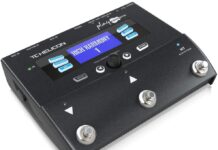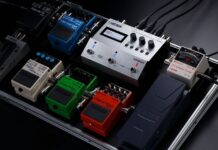There are a ton of different vocal effects processors that are available on the market; some of these vocal effects pedals have specific single uses, and examples of this are vocal looper pedals, vocal autotune pedals, and so forth.2
The other vocal effects processors have a range of vocal effects that are fused within the same physical unit. And because of this, this unit is a bit more expensive than if all of the above-mentioned effects were purchased separately.
Some of the very commonly used vocal effects include:
Harmony – Gives 1 – 2 extra vocal harmonies above/below the main inputted signal.
Looping – This gives a looped reiteration of the inputted signal until it is turned off.
Dedicated inputs/outputs for external instruments which will be plugged in – This one is an extra feature and it is especially useful for singers that also play the guitar.
Pitch correction – This gives a frequency nudge of the inputted signal, and this depends on whether it is a bit sharp or flat.
There are several vocal effects to choose from and they include vocal delay, reverb echo, voice doubling, chorus, and so forth.
Vocal Effects Pedals for Live Performances and Studio Recording
Vocal effects processors are a great solution for artists that are in search of one pedal on stage or in the studio. A very common mistake that singers make, who might not know much about vocal effects pedals, is that they do not spend enough money on one.
What you should remember is that this single vocal effects unit will save you the job of you having to purchase:
- Separate pedals
- A pedal board
- An external power supply, and
- Plenty of ¼-inch jack leads to inter-link these processors.
All these equipment would cost you hundreds of dollars to buy; so, it is worth making a decent initial investment into a vocal multi-effects pedal, and this is only if you are looking at having multiple vocal effects in one particular unit.






